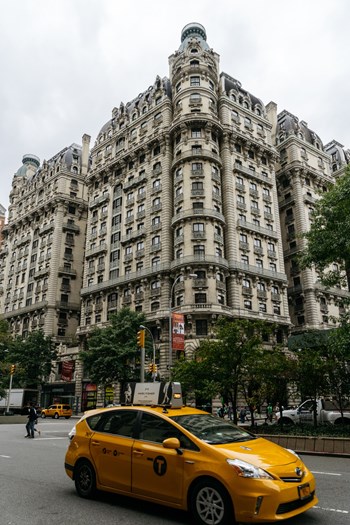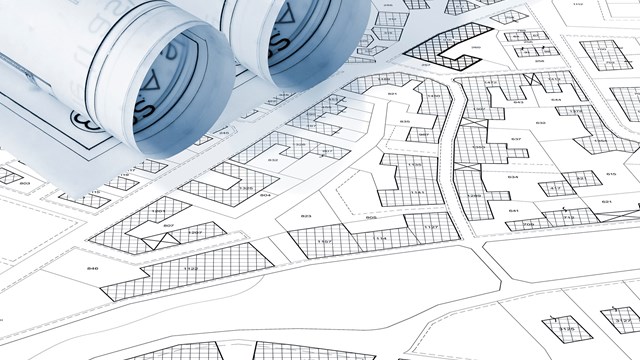
If you picture a specific American city in your head, what do you see? Its buildings, most likely. Cities come to be known and represented by their iconic buildings, one part often standing in for the whole: think the Empire State or Chrysler Building for New York, for example, or the John Hancock Building or the Willis Tower for Chicago. The architecture of an entire neighborhood can represent a city, too, such as the Victorian and Edwardian properties of Boston’s Back Bay or the tropical Art Deco structures of Miami’s South Beach.
But cities are dynamic and ever-evolving. Buildings go through structural and aesthetic changes, get repurposed or redeveloped, and eventually (in the grand scheme of things, at least) meet their demise. Neighborhood borders fluctuate. Cultural and political shifts have influence on where, why, and how buildings are built—or torn down. Economic waves ripple through built environments in ways that change their fundamental character. So how do historically or architecturally significant buildings—specifically, common-interest multifamily residential buildings—survive?
Historic Preservation
According to Ward Miller, Executive Director of Preservation Chicago, a nonprofit dedicated to protecting and revitalizing historic structures and spaces in “America’s City of Architecture,” the urban preservation movement in America was instigated with the demolition of the original (and magnificent, according to those who knew it) Penn Station in New York, which began in 1963, as well as the spate of tear-downs and disinvestment along and around Chicago’s Randolph Street in the same era.
Public outcry and organization led to the formation of local preservation groups in the private and nonprofit sectors, with local governments following suit. The New York City Landmarks Preservation Commission (along with similar offices in other U.S. cities) was among these. The National Historic Preservation Act of 1966 then gave the U.S. Department of the Interior the authority to create an official National Register of Historic Places.
According to the National Park Service website, a property must meet certain criteria involving its age, significance, and integrity to be considered eligible for the register. Specifically, it should be at least 50 years old, retain its original appearance, and/or have an association with an important event, person, style, or achievement from the past. Once listed, a property or district is granted certain benefits, including tax incentives and eligibility for grants and other federal funding. Anyone or any group can submit a nomination to the State Historic Preservation Office (SHPO) of the property in question, but usually it is initiated by the property owners themselves, or by historical societies, preservation organizations, or governmental agencies, says Miller.
A listing in the National Register does not in and of itself protect the property, however. Unless the property is receiving federal assistance, federal law prohibits the government from restricting what a non-federal owner is allowed to do with it—up to and including destruction. The owner also has the right to object to being listed. Registered properties get a distinctive plaque and searchability in the database, which might make them an attraction for visitors—but they’re not required to be made publicly accessible. In the case of a registered district, the area will not be listed if the majority of owners object.
Local Landmarks
The true protection and preservation, then, comes from the local agencies and organizations that grant landmark or historic status to a property or district. Each region’s processes, criteria, and overall missions and values can differ.
In Boston, for example, local landmark designation depends on proof of significance beyond the local level, meaning that a site has to be significant to the state, the region, or nation as a whole.
“That’s a really high bar,” explains Alison Frazee, Executive Director of the Boston Preservation Alliance, the nonprofit group that operates through the city’s Landmarks Commission, “and we have a lot of places with historic significance that are not protected because of that, especially places that have significance to black and brown communities, women’s history, LGBTQ history—stories and histories that aren’t as well documented as those related to our white, wealthier neighborhoods and individuals.”
But the Alliance itself is looking to change that, Frazee says. Working with City Councilor Kenzie Bok, the group is pushing to amend the statute “so that we can protect places that are significant just at the local level, which will open up the opportunity to protect places that are meaningful to Bostonians all across the city.”
Once a property or district has a landmark or historic designation, any alterations, improvements, repairs, or replacements that are visible from the public way are under the purview of that district’s commission. Frazee says that commissioners are homeowners or business owners from that neighborhood who have experience or knowledge related to architecture, preservation, or history.
The Landmarks Commission has no capital budget or allocated funding per se. Boston’s Community Preservation Act places a surcharge on property tax, explains Frazee, funds from which are pooled and distributed for historic preservation, parks and open space, and affordable housing. Landmarked or National Register properties can bypass the approval process when they apply for such funds; otherwise, the Landmarks Commission has to sign off on the applicant’s historical significance.
Miller says the Commission of Chicago Landmarks is similarly underfunded, as well as understaffed. Its members, appointed by the Mayor, serve on a volunteer basis. They are responsible for recommending to the City Council which individual buildings, sites, objects, or districts should be designated as Chicago Landmarks and thus protected by law. Prospects must meet at least two out of seven criteria to be eligible for consideration: an architect of note, an important architectural style, site of a significant historic event, identification with a significant person, example of the city’s heritage, distinctive theme as a district, and a feature of uniqueness or rarity. Additionally, the site or structure must meet an integrity standard, “meaning that its historic or aesthetic importance must have been substantially maintained,” explains Miller.
Historical Value
Seems like a lot of red tape for a property owner, particularly a residential board, to submit to a landmark designation, or for a developer to rehab a building in a historic district. What’s the upside?
For Ron Castellano, a New York architect and developer who specializes in restoring and redeveloping historically significant buildings in the city and elsewhere, being in that niche is essentially a labor of love. Not only are there the limitations and extra steps involved with working on a landmark building or in a landmark district, there are also challenges inherent in converting a structure to a use for which it was not originally intended.
“These are buildings that might be 100 or more years old,” he says, “and they weren’t originally meant to be lived in. They are lofts, factories, warehouses—and many of them have gone unmaintained for a long time.”
Speaking about the Forward Building, the 1912 Beaux-Arts beacon of the Lower East Side that Castellano acquired in 2004 and converted to unique condominiums, he maintains that “doing it right the first time” is key to the success of such redevelopments. “This does not just pertain to the [Landmarks] protected façades,” he continues, “but to the guts, the mechanicals, the insulation and weatherproofing.”
While such a condo might not have the ultramodern accouterments of shiny new neighbors like the 75-story One Manhattan Square down the street, there is something to be said for a 111-year-old building that exemplifies a neighborhood’s generations of cultural and historic significance. Living in a stop on many of the area’s popular walking tours has its own element of prestige.
“The thing about condos,” says Castellano, “is that you have to buy into that notion that you have a jewel in the neighborhood. Purchasers need to know and have that appreciation.” While they may not have a golf simulator or a tranquility garden, residents of the Forward Building know that they are living in a piece of history, and that the original beauty (and quirkiness) of its exterior will always be protected.
The calculus is the same in Chicago, says Miller, adding that “Residents of modern highrises are some of the biggest supporters of historic preservation, since retaining smaller structures enhances quality of life, neighborhood character, and access to light and air.” Those views that add so much value and marketability to the new developments are made possible, in part, by the protection and preservation of the surrounding smaller historic structures.
While it can cost more in time, labor, and materials to maintain or restore a landmark building, the designation does have its financial perks, Miller adds. Chicago has a developer-sponsored Neighborhood Opportunity Fund, 10% of which funnels to landmarks undergoing exterior work (or occasionally interior projects if that component is publicly accessible). He notes that if the work is being performed to comply with local law or code, the Commission on Chicago Landmarks cannot deny it.
Preserving the Past, Protecting the Future
Both Miller and Frazee emphasize that preservationists are not anti-development. They want to see unused buildings and disinvested areas get revitalized, specifically by redeveloping historic structures and protecting an area’s historic resources. “We strongly believe that a building needs to be used,” says Frazee. “If we don’t use it, we lose it eventually. So we want to keep buildings modern and updated. We want them to be appropriate for their user groups. …If we want to keep that historic identity and that historic character, we have to invest in it. We have to prioritize it.”
Miller adds that sensitive development is the goal, and this starts with architectural training. He believes that “Aspiring architects should be less motivated by putting their mark on the world with new buildings and more by what they can do to restore and repurpose existing buildings, which might result in better design and community integration.”
“There’s this false narrative,” adds Frazee, “that old is bad, that old buildings are falling down, that they’re constant work, that they’re not environmentally friendly. And that’s just not always true. There’s always going to be some buildings that are in bad shape, but even new construction is going to need maintenance.”
As more and more focus is placed on how the built environment contributes to climate impact, historic preservation offers a chance to not only protect the past, but to ensure that the Earth remains habitable for the future. “The most environmentally friendly thing we can do is reusing what we have,” says Frazee. “Preservationists have always said that the greenest building is the one that already exists. Building reuse is climate action. We talk a lot about recycling cans and bottles and having reusable bags and cups. We don’t seem to care about demolishing a building even though there’s nothing in your whole life you could do to counter the environmental impact of the demolition of one house.”
Darcey Gerstein is Associate Editor and a Staff Writer for CooperatorNews.






Leave a Comment